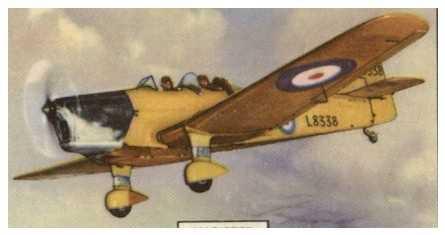Miles M.14 Magister
Many of the young servicemen buried at Repton during the Second World War were based at Branston airfield, and died while learning (or training others) to fly, the majority of them in the Miles M.14 Magister.

Based on the civilian Miles Hawk, the Magister was designed as an elementary trainer, the first low-wing monoplane trainer in the history of the Royal Air Force. Compared with the Hawk, it had a larger cockpit and blind-flying equipment.
The Magister was, in addition, the first R.A.F. aeroplane in which magnesium alloy castings were used for stressed parts, and the first low-wing cantilever monoplane with full Air Ministry approval for acrobatic flying, including protracted spins.
The 'all-wooden' trainer was first delivered in May 1937, but a number were initially lost, unable to recover from spinning. In consequence the Magister was extensively redesigned and both modified and subsequent production aircraft had the designation M.14A.
At the time of the Magister's introduction, the Hurricane and Spitfire were coming into service, and the new trainer, with its low-wing monoplane characteristics and split trailing-edge flaps, reproduced the handling qualities of these types in a safe manner. It equipped 16 Elementary Flying Training Schools (including those at Ashbourne, Burnaston and Church Broughton) and the Central Flying School; in addition, it saw service with the British army and the Fleet Air Arm.
A total of 1293 were built between 1937 and 1941, the last being retired in 1948.